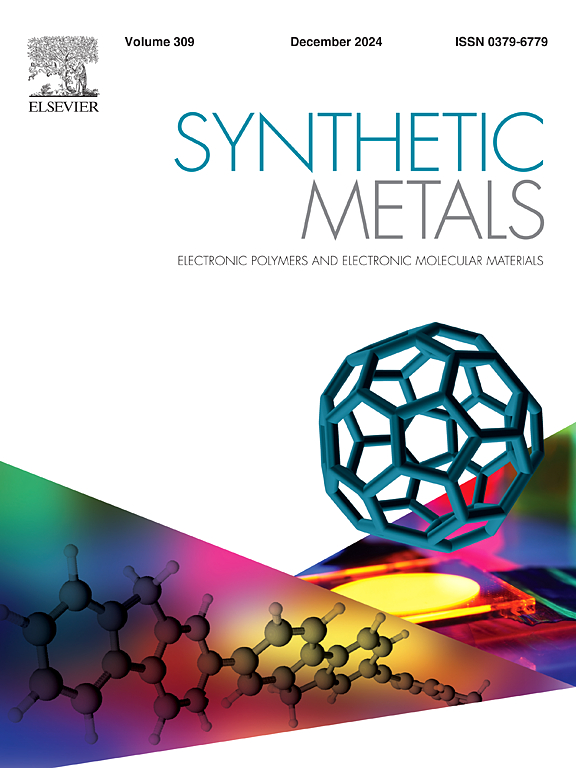用于高效聚合物太阳能电池的半平面-半扭曲含硒酚的窄带隙小分子
IF 4.6
3区 材料科学
Q2 MATERIALS SCIENCE, MULTIDISCIPLINARY
引用次数: 0
摘要
含有扭曲骨架的小分子电子受体(sma)的聚合物太阳能电池(PSCs)与扁平分子相比具有许多优点,包括能够移动分子能级、增强电荷提取性能、更高的消光系数、更长的载流子寿命和更低的重组率。总的来说,这些优势有助于psc的功率转换效率(PCE)。然而,扭曲sma的有限吸收光谱给进一步提高性能带来了挑战。为了解决这一问题,设计并合成了以茚二烯二烯(IDSe)段为给电子单元,端基卤化的3种受体-π-给体-π ' -受体型sma。利用IDSe熔合环核的强给电子能力和引入的异构化π桥段,所有sma都在近红外区表现出红移吸收,并成功地生成了半平面半扭曲骨架。当与J52混合时,两种卤化SMAs (h-IDSe-4F和h-IDSe-4Cl)的器件表现出较好的激子解离性、较低的重组速率、平衡的电荷迁移率和较高的电荷迁移率,其效率分别为9.33 %和9.03 %,高于h- ids基器件的5.07 %。本研究表明,调整共轭主链的平面度、微调核心单元和端基的卤化取代对调节有机光伏器件的光收集和性能有重要影响。本文章由计算机程序翻译,如有差异,请以英文原文为准。
Semi-planar-semi-twisted selenophen-containing narrow bandgap small molecules for efficient polymer solar cells
Polymer solar cells (PSCs) containing small molecule electron acceptors (SMAs) with twisted backbones offer many advantages over flat molecules, including the ability to move molecular energy levels, enhanced charge extraction properties, higher extinction coefficients, longer carrier lifetimes, and lower recombination rates. Collectively, these advantages contribute to the power conversion efficiency (PCE) of PSCs. However, the restricted absorption spectra of twisted SMAs present a challenge to further performance improvement. To address this issue, three acceptor-π-donor-π’-acceptor-type SMAs with indacenodiselenophene (IDSe) segment as the electron-giving unit and halogenated end groups were designed and synthesized. Taking advantage of the strong electron donating ability of the IDSe fusing ring core and the introduced isomerized π bridged segments, all SMAs exhibit red-shifted absorption in the near-infrared region and successfully generate a semi-planar semi-twisted backbone. When blended with J52, the devices of the two halogenated SMAs (h-IDSe-4F and h-IDSe-4Cl) showed preferable exciton dissociations, low recombination rates, balanced and high charge mobilities, leading to high efficiencies of 9.33 % and 9.03 %, higher than the 5.07 % of the h-IDSe-based device. This work demonstrates that tuning the planarity of the conjugated backbone, fine-tuning the core unit, and halogenation substitutions in the end groups have a significant impact on regulating the light-harvesting and performance of organic photovoltaic devices.
求助全文
通过发布文献求助,成功后即可免费获取论文全文。
去求助
来源期刊

Synthetic Metals
工程技术-材料科学:综合
CiteScore
8.30
自引率
4.50%
发文量
189
审稿时长
33 days
期刊介绍:
This journal is an international medium for the rapid publication of original research papers, short communications and subject reviews dealing with research on and applications of electronic polymers and electronic molecular materials including novel carbon architectures. These functional materials have the properties of metals, semiconductors or magnets and are distinguishable from elemental and alloy/binary metals, semiconductors and magnets.
 求助内容:
求助内容: 应助结果提醒方式:
应助结果提醒方式:


